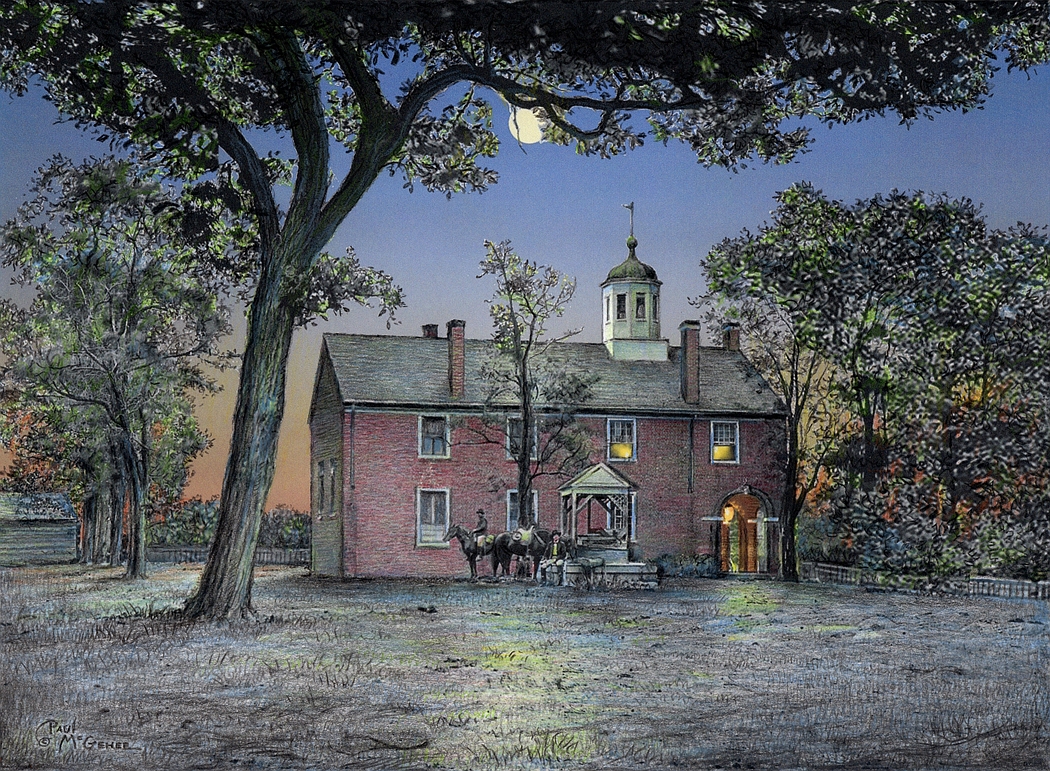|
"Old
Fairfax Courthouse" by Paul McGehee. Built in 1799 as the seat of
government for the growing county of Fairfax, Virginia, the courthouse
building has been the scene of many historical occurences. The first
court session held in the new building was concerning the recording of
the will of George Washington's nephew Corbin Washington. The
courthouse was later to hold the wills of both George and Martha
Washington. Through the years of the early 19th century, the courthouse
grounds saw everything from public hangings to slave auctions, typical
of those turbulent days of the young United States. The courthouse
grounds also became the town meeting place of businessmen, whose
gatherings later became festive occasions known as "court days." On
April 12, 1861 a new chapter unfolded for the Fairfax Courthouse and
the young nation as Civil War broke out following the attack on Fort
Sumter at the Charleston, South Carolina harbor. As tensions quickly
mounted in Northern Virginia, a local militia known as the Fairfax
Rifles met on the Fairfax Courthouse grounds to map out strategies for
defense of Virginia. In the days following the outbreak of war,
Virginia (soon to become Confederate) forces occupied the Fairfax
Courthouse. In the wee hours of the morning on May 31, 1861 the 210
Virginia troops at the courthouse found themselves engaged in a
surprise attack from Union Cavalry forces. The ensuing chaotic skirmish
led to the first death of a Confederate officer in the Civil War,
Captain John Quincy Marr, who commanded the men of the Warrenton
Rifles. The attack on Fairfax Courthouse was to go down in history as
the first land battle of the Civil War between northern and southern
forces. Although the Union forces retreated after the battle, they were
to return a few weeks later. By July, Fairfax Courthouse fell into
Union hands and the Confederates abandoned the area, as all eyes and
manpower on both sides were focusing on the huge battle yet to come at
Manassas, Virginia and Bull Run. During the Union occupation of the
courthouse building, many important documents were destroyed...however,
the quick thinking of the court clerk saved the will of George
Washington, who secretly took it on horseback by night for safekeeping
in Richmond. Whereas those historic papers were returned to the
courthouse after the end of the war, Martha Washington's will papers
were found and taken by a Union soldier who many years later sold the
historic documents to J. P. Morgan for a tidy sum of money. Martha's
will papers remained in the possession of the Morgan family for many
years but was eventually returned to the Fairfax Courthouse, where they
are now both on display in the County Clerk's office. Today, the old
Fairfax Courthouse has been restored and is one of the oldest and most
historic places in northern Virginia. Newer buildings on the grounds
still serve as the local Circuit Court and District Court. A cannon is
in place to remind passersby of its historic past, and a monument has
been erected in memory of Captain Marr. "Old Fairfax Courthouse" is
faithfully reproduced as an
archival-quality print from McGehee's original color pencil drawing in
a limited edition of only 500 pieces,
each hand-signed by the artist.
|


